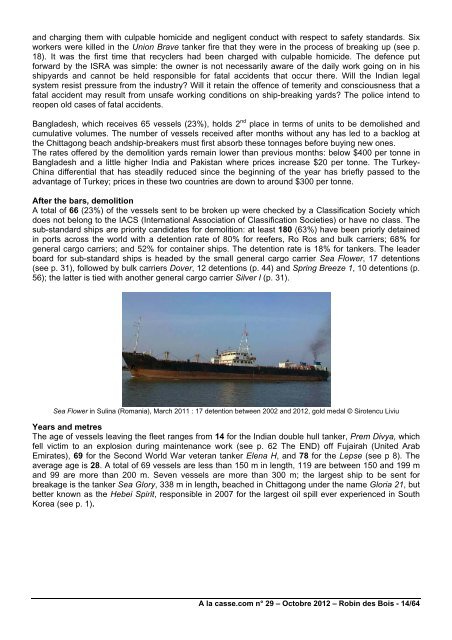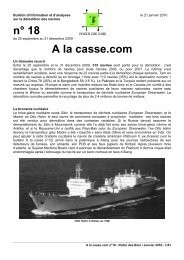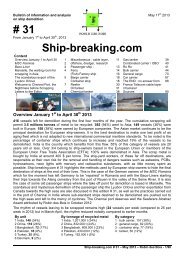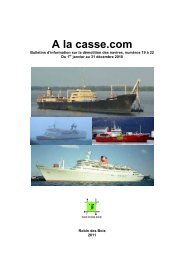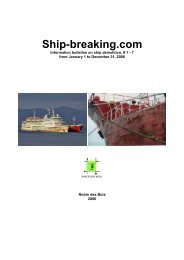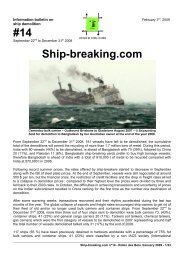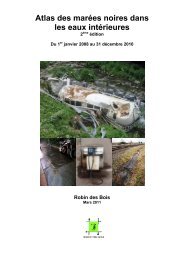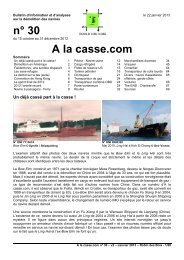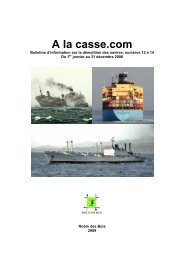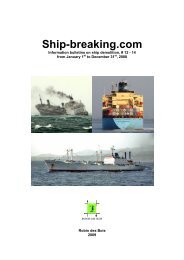# 29 Ship-breaking.com - Robin des Bois
# 29 Ship-breaking.com - Robin des Bois
# 29 Ship-breaking.com - Robin des Bois
Create successful ePaper yourself
Turn your PDF publications into a flip-book with our unique Google optimized e-Paper software.
and charging them with culpable homicide and negligent conduct with respect to safety standards. Six<br />
workers were killed in the Union Brave tanker fire that they were in the process of <strong>breaking</strong> up (see p.<br />
18). It was the first time that recyclers had been charged with culpable homicide. The defence put<br />
forward by the ISRA was simple: the owner is not necessarily aware of the daily work going on in his<br />
shipyards and cannot be held responsible for fatal accidents that occur there. Will the Indian legal<br />
system resist pressure from the industry? Will it retain the offence of temerity and consciousness that a<br />
fatal accident may result from unsafe working conditions on ship-<strong>breaking</strong> yards? The police intend to<br />
reopen old cases of fatal accidents.<br />
Bangla<strong>des</strong>h, which receives 65 vessels (23%), holds 2 nd place in terms of units to be demolished and<br />
cumulative volumes. The number of vessels received after months without any has led to a backlog at<br />
the Chittagong beach andship-breakers must first absorb these tonnages before buying new ones.<br />
The rates offered by the demolition yards remain lower than previous months: below $400 per tonne in<br />
Bangla<strong>des</strong>h and a little higher India and Pakistan where prices increase $20 per tonne. The Turkey-<br />
China differential that has steadily reduced since the beginning of the year has briefly passed to the<br />
advantage of Turkey; prices in these two countries are down to around $300 per tonne.<br />
After the bars, demolition<br />
A total of 66 (23%) of the vessels sent to be broken up were checked by a Classification Society which<br />
does not belong to the IACS (International Association of Classification Societies) or have no class. The<br />
sub-standard ships are priority candidates for demolition: at least 180 (63%) have been priorly detained<br />
in ports across the world with a detention rate of 80% for reefers, Ro Ros and bulk carriers; 68% for<br />
general cargo carriers; and 52% for container ships. The detention rate is 18% for tankers. The leader<br />
board for sub-standard ships is headed by the small general cargo carrier Sea Flower, 17 detentions<br />
(see p. 31), followed by bulk carriers Dover, 12 detentions (p. 44) and Spring Breeze 1, 10 detentions (p.<br />
56); the latter is tied with another general cargo carrier Silver I (p. 31).<br />
Sea Flower in Sulina (Romania), March 2011 : 17 detention between 2002 and 2012, gold medal © Sirotencu Liviu<br />
Years and metres<br />
The age of vessels leaving the fleet ranges from 14 for the Indian double hull tanker, Prem Divya, which<br />
fell victim to an explosion during maintenance work (see p. 62 The END) off Fujairah (United Arab<br />
Emirates), 69 for the Second World War veteran tanker Elena H, and 78 for the Lepse (see p 8). The<br />
average age is 28. A total of 69 vessels are less than 150 m in length, 119 are between 150 and 199 m<br />
and 99 are more than 200 m. Seven vessels are more than 300 m; the largest ship to be sent for<br />
breakage is the tanker Sea Glory, 338 m in length, beached in Chittagong under the name Gloria 21, but<br />
better known as the Hebei Spirit, responsible in 2007 for the largest oil spill ever experienced in South<br />
Korea (see p. 1).<br />
A la casse.<strong>com</strong> n° <strong>29</strong> – Octobre 2012 – <strong>Robin</strong> <strong>des</strong> <strong>Bois</strong> - 14/64


